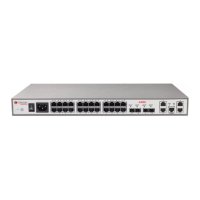A10E/A28E/A28F Configuration Guide
Unicast: when a MAC address entry, related to the destination MAC address of a packet,
is listed in the MAC address table, the A10E/A28E will directly forward the packet to the
receiving port through the egress port of the MAC address entry. If the entry is not listed,
the A10E/A28E broadcasts the packet to other devices.
Multicast: when the A10E/A28E receives a packet of which the destination MAC
address is a multicast address, and multicast is enabled, the A10E/A28E sends the packet
to the specified Report interface. If an entry corresponding to the destination address of
the packet is listed in the MAC address table, the A10E/A28E transmits the packet from
the egress port of the entry. If the corresponding entry is not listed, the A10E/A28E
broadcasts the packet to other interfaces except the receiving interface.
Broadcast: when the A10E/A28E receives a packet with an all-F destination address, or
its MAC address is not listed in the MAC address table, the A10E/A28E forwards the
packet to all ports except the port that receives this packet.
Classification of MAC addresses
MAC address table is divided into static address entry and dynamic address entry.
Static MAC address entry: also called "permanent address", added and removed by the
user manually, does not age with time. For a network with small device change, adding
static address entry manually can reduce the network broadcast flow, improve the
security of the interface, and prevent table entry from losing after the system is reset.
Dynamic MAC address entry: the Switch can add dynamic MAC address entry through
MAC address learning mechanism. The table entries age according to the configured
aging time, and will be empty after the system is reset.
The A10E/A28E supports the maximum 16K dynamic MAC addresses, and each interface
supports 1024 static MAC addresses.
Aging time of MAC addresses
There is capacity restriction to the MAC address table of the A10E/A28E. In order to
maximize the use of address forwarding table resources, the A10E/A28E uses the aging
mechanism to update MAC address table, i.e.in the meantime of creating a certain dynamic
table entry, open the aging timer, if there is no MAC address packet from the table entry
during the aging time, the A10E/A28E will delete the MAC address entry.
The A10E/A28E supports aging for MAC addresses. The aging time ranges from 10s to
1000000s, and can be 0 which indicates no aging.
The aging mechanism takes effect on dynamic MAC addresses only.
MAC address forwarding policies
The MAC address table has two forwarding policies:
When receiving packets on an interface, the A10E/A28E searches the MAC address table for
the interface related to the destination MAC address of packets.
If successful, it forwards packets on the related interface, records the source MAC
address of packets, interface number of ingress packets, and VLAN ID in the MAC

